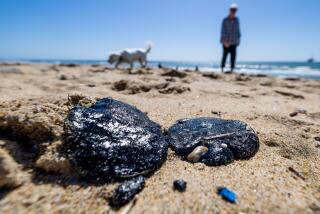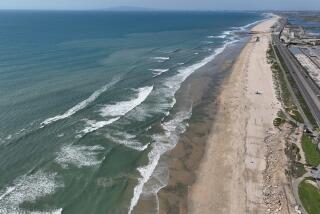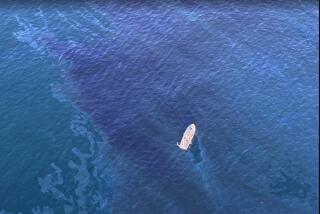Oil Slick Moving Away From Sensitive Areas
SANTA BARBARA — Oil continued to bubble up Wednesday from a sunken freighter off Point Conception, but favorable wind and current conditions kept the approximately seven-mile-long slick moving away from the shore and the nearby Channel Islands, authorities reported.
The slick had moved about five miles from the location 15 miles offshore where the Liberian freighter Pac Baroness sank early Monday after colliding in fog with another ship, the Coast Guard said.
But the slick was moving northwest, away from the most sensitive environmental areas, said Capt. Robert Janecek, commander of the Long Beach Coast Guard station and coordinator of the cleanup effort.
Authorities said conditions could change and the oil slick, which carries the potential for serious environmental damage, could move toward land.
“It may be months before we determine the overall impact of the incident,” said Reed Smith, a lieutenant with the California Fish and Game Department.
Representatives from the Department of Fish and Game, the Coast Guard, the National Oceanic and Atmospheric Administration and the U.S. Environmental Protection Agency also participated in the press conference.
A plume of oil about 300 feet wide flowed from the ship Wednesday, Janecek said. But “the flow has decreased” during the last two days, he said. The total amount spilled is undetermined.
Three cleanup vessels operated by Clean Seas Inc., a private firm under contract to the owner of the sunken freighter, skimmed about 2,800 gallons of oil from surface Wednesday. Huge booms contain the oil, and then the oil is skimmed from the water and pumped aboard the ship. Another 2,800 gallons were removed Tuesday.
The freighter had about 386,000 gallons aboard when it sank. Coast Guard spokesman Charles Embleton called the oil skimmed a token amount. Skimming is not very successful with a fuel oil spill, as opposed to a crude oil spill, because fuel oil has been refined and is much thinner, he said.
Environmental scientists agree that the oil can cause serious damage to larvae and fish in the area. But there is division over the danger posed by the sunken ship’s cargo: 23,000 tons of powdered copper, iron and sulfur concentrates.
Smith of the Fish and Game Department announced that the ore will not be a serious environmental hazard because it does not dissolve easily.
But scientists at the University of California, Santa Barbara, are concerned about the ore, said Richard Zimmer-Faust, a research biologist at the university’s Marine Sciences Institute.
“The solubility is low, but there is still the possibility of a long-term chronic effect,” he said. “It’s premature to say there won’t be any environmental damage.”
The cause of the collision between the Pac Baroness, a bulk carrier, and the automobile-carrying ship Atlantic Wing early Monday has still not been determined.
The Atlantic Wing, registered in Panama, was en route to Long Beach for fuel when its bow crashed into the side of the Pac Baroness in thick fog.
The hull of the Pac Baroness was slashed open below the waterline, and it sank 11 hours later. There were no injuries, and the crew of 25 was evacuated.
More to Read
Sign up for Essential California
The most important California stories and recommendations in your inbox every morning.
You may occasionally receive promotional content from the Los Angeles Times.










